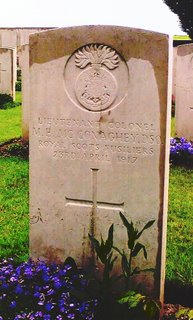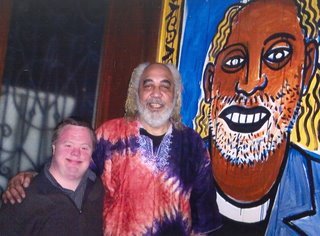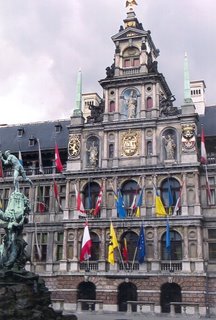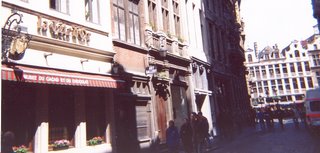 Menen Gate, Ieper (Ypres), Belgium. With rainbow.
Menen Gate, Ieper (Ypres), Belgium. With rainbow.Ieper (Ypres) was the site of prolonged battles in WWI. It is near the French border. Arras is not far. See a film about the trench warfare and the area at ://www.youtube.com/watch?v=ev3oDFtA3Es&feature=fvw/
The town, bombed out, has been reconstructed and this Gate is the site of daily taps-memorials-services for whatever group has scheduled itself for that time. There are readings of names, and a small service, color guards. Note the rainbow. The Gate heads toward the next town, Menen, and groups gather from all different countries here.
We caught the rainbow. No need for advance reservations to spend the night. There are plenty of B&B's, and if the first ones are full, ask if they could refer you. They will probably even call ahead for you, and give you a map.
Wars get personal.
Meet a veteran, my uncle in this 1950's or so photo, who fought at Ypres with the Canadian Army. He used to say that he and his companions called the place "Wipers." He was gassed, but recovered without injury. He did not talk much about the war. He did say that in a convoy of trucks, the one immediately behind his was blown up, no survivors.
 Veteran, Canadian Army, WWI, Ypres (Ieper) Belgium. Salute the work.
Veteran, Canadian Army, WWI, Ypres (Ieper) Belgium. Salute the work.The white square by his glasses must be part of the windowsill?
I have heard the town pronounced as "Eeps" - the French - and "Eeper." German or Dutch? Watch your map, and you will probably find the spelling "Ieper" now.
For a photo gallery, see www.freefoto.com/browse.jsp?id=03-07-0.
The town is in West Flanders, and a war overview is at www.webmatters.net/cwgc/menin_gate. At the beginning of the battle (there were several long ones), people would go out in their carriages and watch.
For all sites, go to the home page first, and only use the rest of the address as is helpful.
People to remember:
Col. John McCrae
John McCrae wrote the famous poem, In Flanders Field, and was Canadian. Read the poem again, and about how and when it was written in 1915, at an Arlington Cemetery site -- www.arlingtoncemetery.net/flanders. His biography is at www.vac-acc.gc.ca/general/sub.cfm?source=history/firstwar/mccrae. See and hear it at ://www.youtube.com/watch?v=Ky2WKqmrnnI; or ://www.youtube.com/watch?v=rpgSQiPqfgE&feature=related
Do not miss the exhibits at the war museum. Panoramas, scenes, reenactments, lights, sound.
And the poem.
"In Flanders fields the poppies blow (1)
Between the crosses, row on row
That mark our place; and in the sky
The larks, still bravely singing, fly
Scarce heard amid the guns below.
We are the Dead. Short days ago
We lived, felt dawn, saw sunset glow,
Loved and were loved, and now we lie
In Flanders fields.
Take up our quarrel with the foe:
To you from failing hands we throw
The torch; be yours to hold it high.
If ye break faith with us who die
We shall not sleep, though poppies grow
In Flanders fields."
 Grave, Lt. Col. Maurice McConaghey, Arras, France, WWI
Grave, Lt. Col. Maurice McConaghey, Arras, France, WWI Ypres (Ieper) Belgium, relief map, salient, WWI
Ypres (Ieper) Belgium, relief map, salient, WWI Bonaparte Dock, Antwerp, Belgium. Pan Earth All Cuisines Host
Bonaparte Dock, Antwerp, Belgium. Pan Earth All Cuisines Host Antwerp, Belgium. Pan Earth All Cuisines Art and Host
Antwerp, Belgium. Pan Earth All Cuisines Art and Host Docks, Antwerp, Belgium. Pan Earth All Cuisines Restaurant, Diners and Hostess. Bonapartedok.
Docks, Antwerp, Belgium. Pan Earth All Cuisines Restaurant, Diners and Hostess. Bonapartedok. Rubens at Antwerp, Belgium
Rubens at Antwerp, Belgium Butcher's Hall, Medieval. Antwerp, Belgium
Butcher's Hall, Medieval. Antwerp, Belgium Town Hall, Antwerp, Belgium
Town Hall, Antwerp, Belgium Langewapper, Steen Castle, Antwerp, Belgium. Clerically abbreviated. Lange Wapper to be imagined.
Langewapper, Steen Castle, Antwerp, Belgium. Clerically abbreviated. Lange Wapper to be imagined. Escargots cart, Brussels, Belgium
Escargots cart, Brussels, Belgium Michael Jackson stage set, Brusssels, Belgium. Main square. Concert pending.
Michael Jackson stage set, Brusssels, Belgium. Main square. Concert pending.  Chocolatier, Chocolate Factory, Brussels, Belgium
Chocolatier, Chocolate Factory, Brussels, Belgium